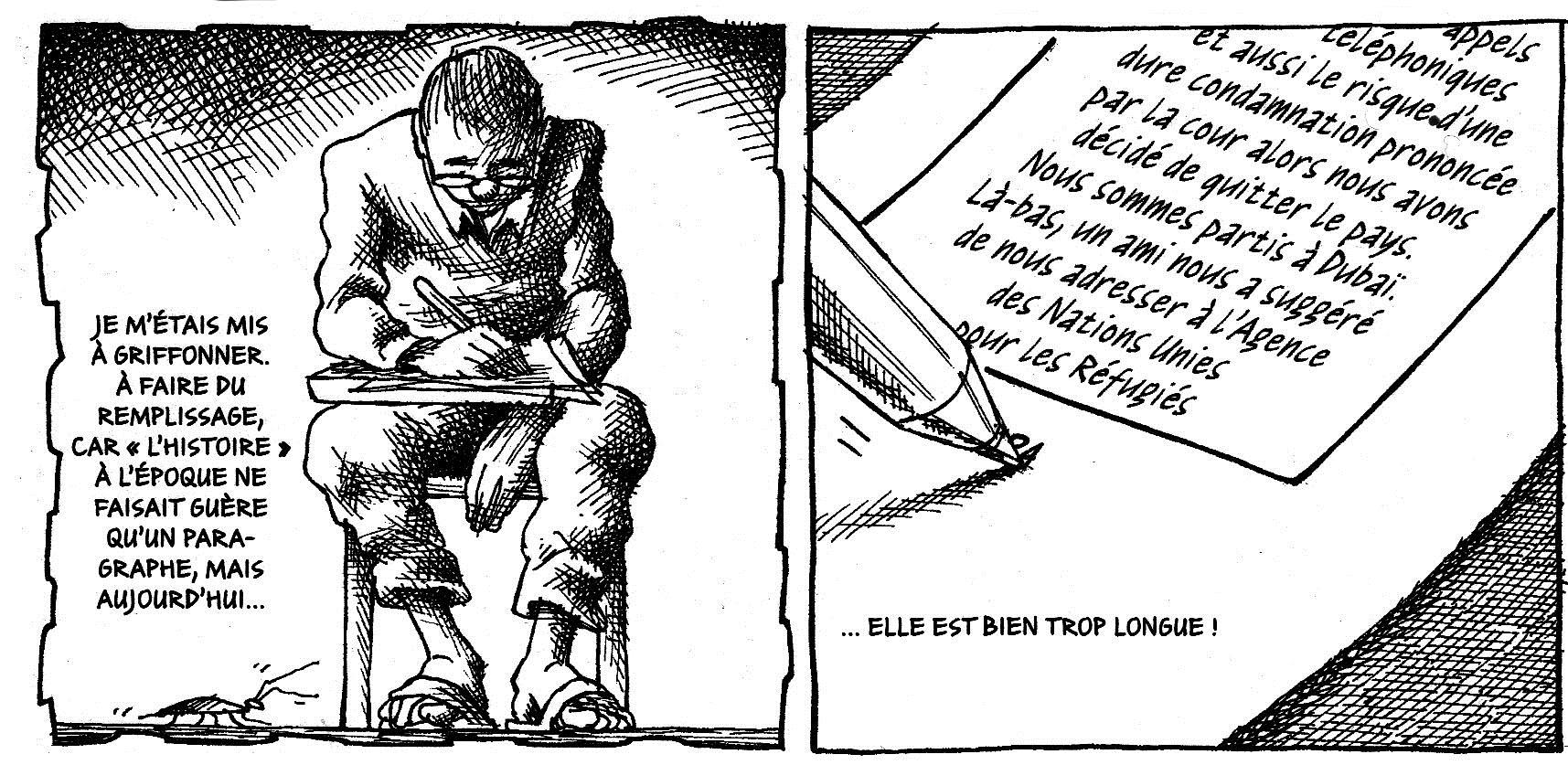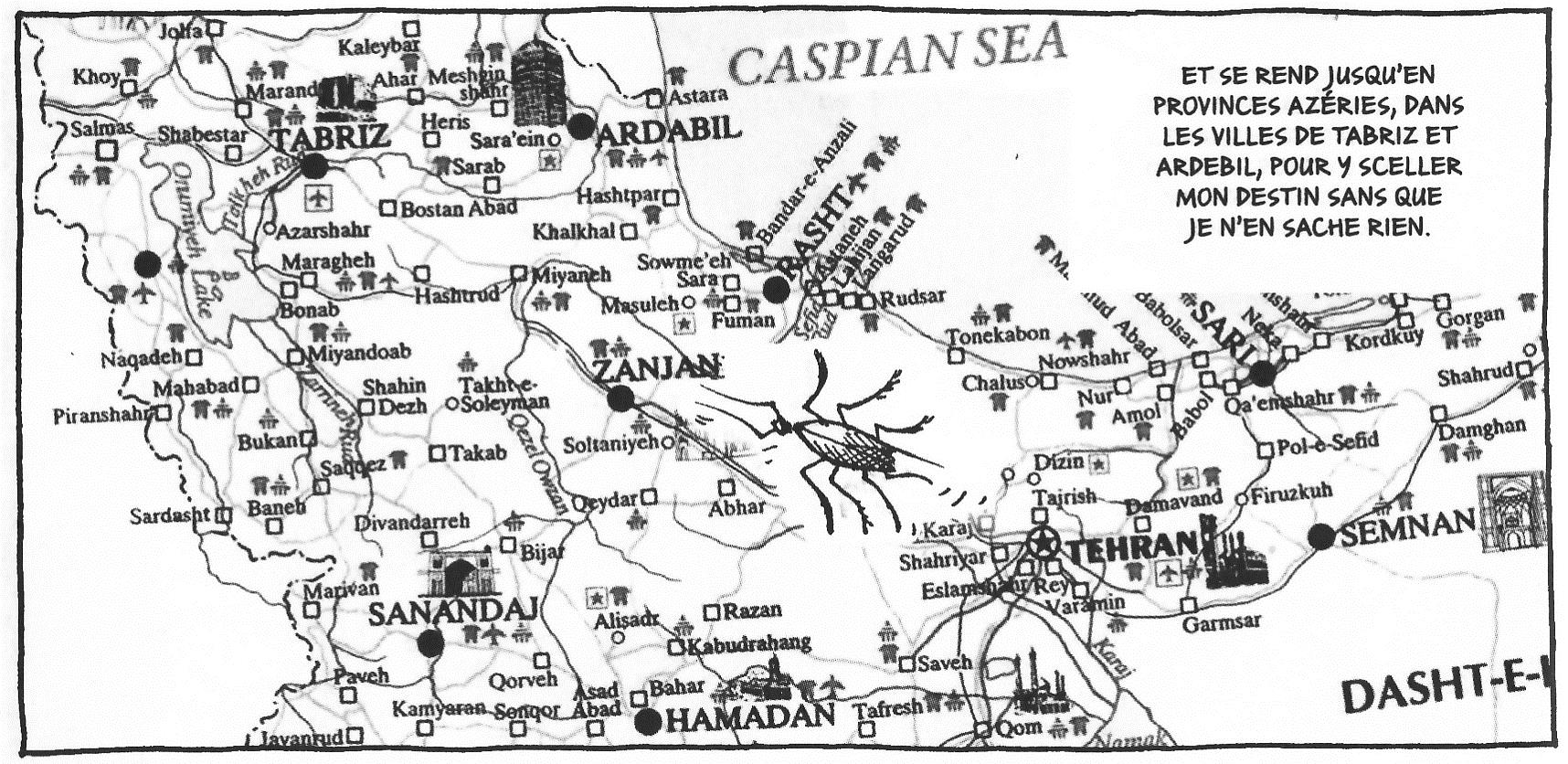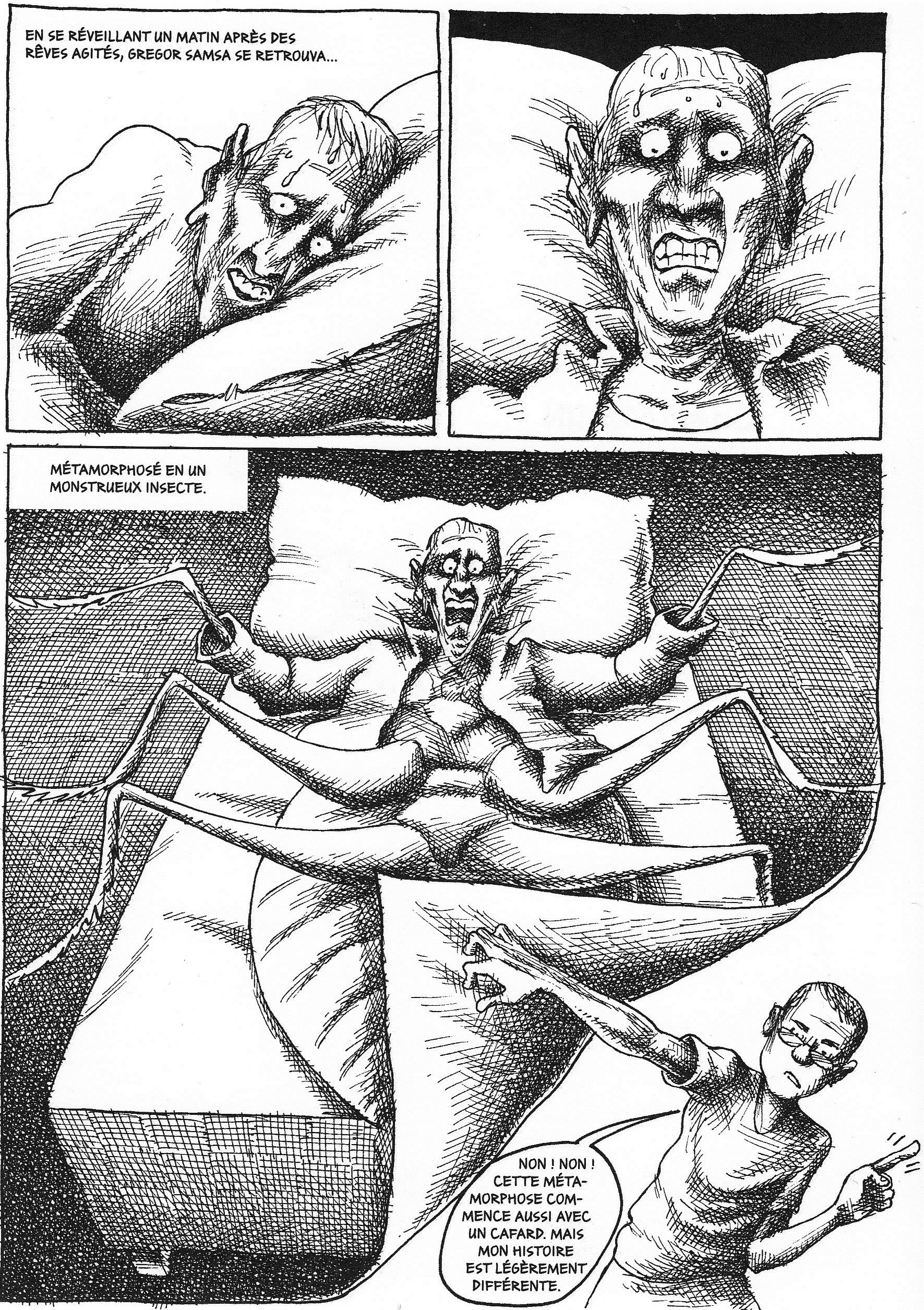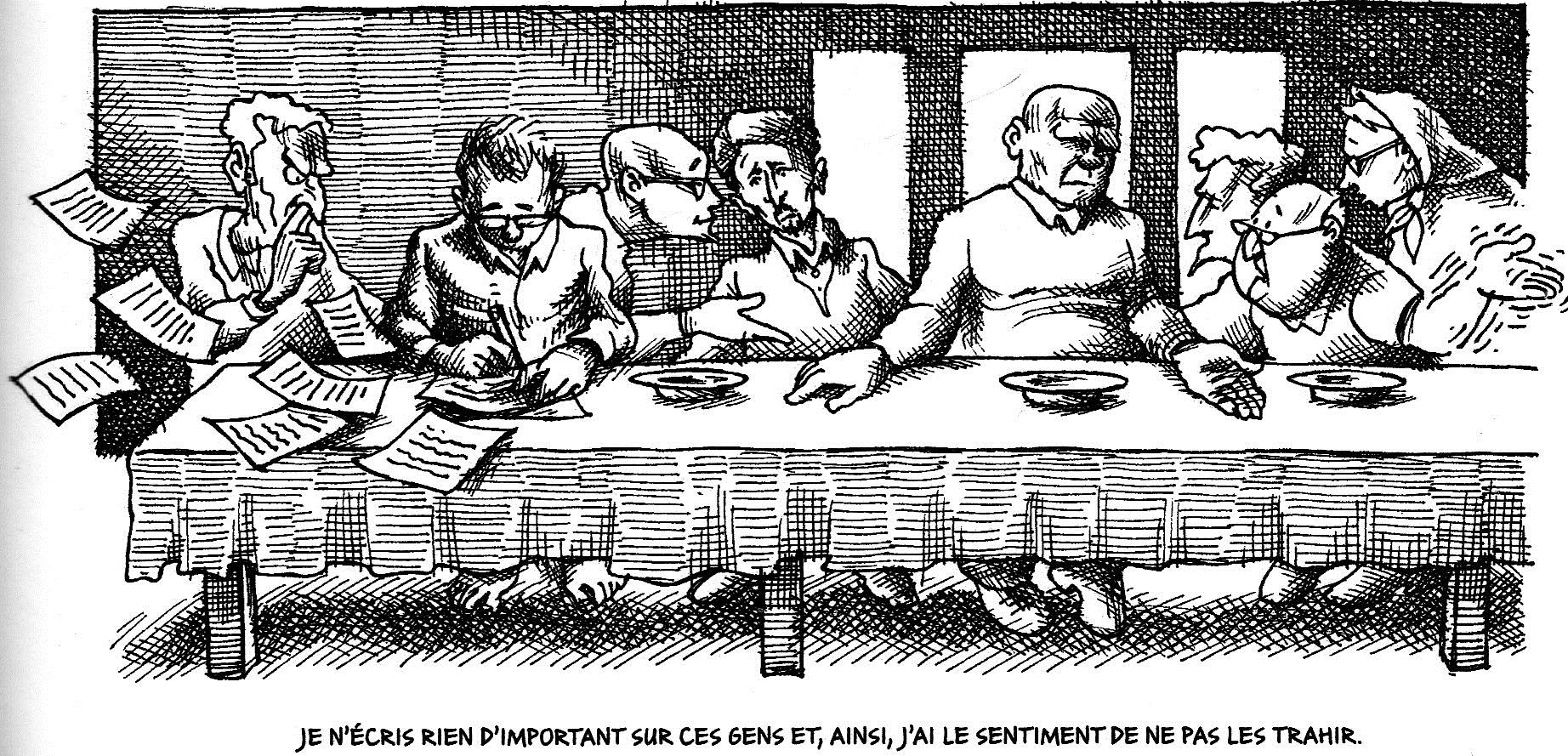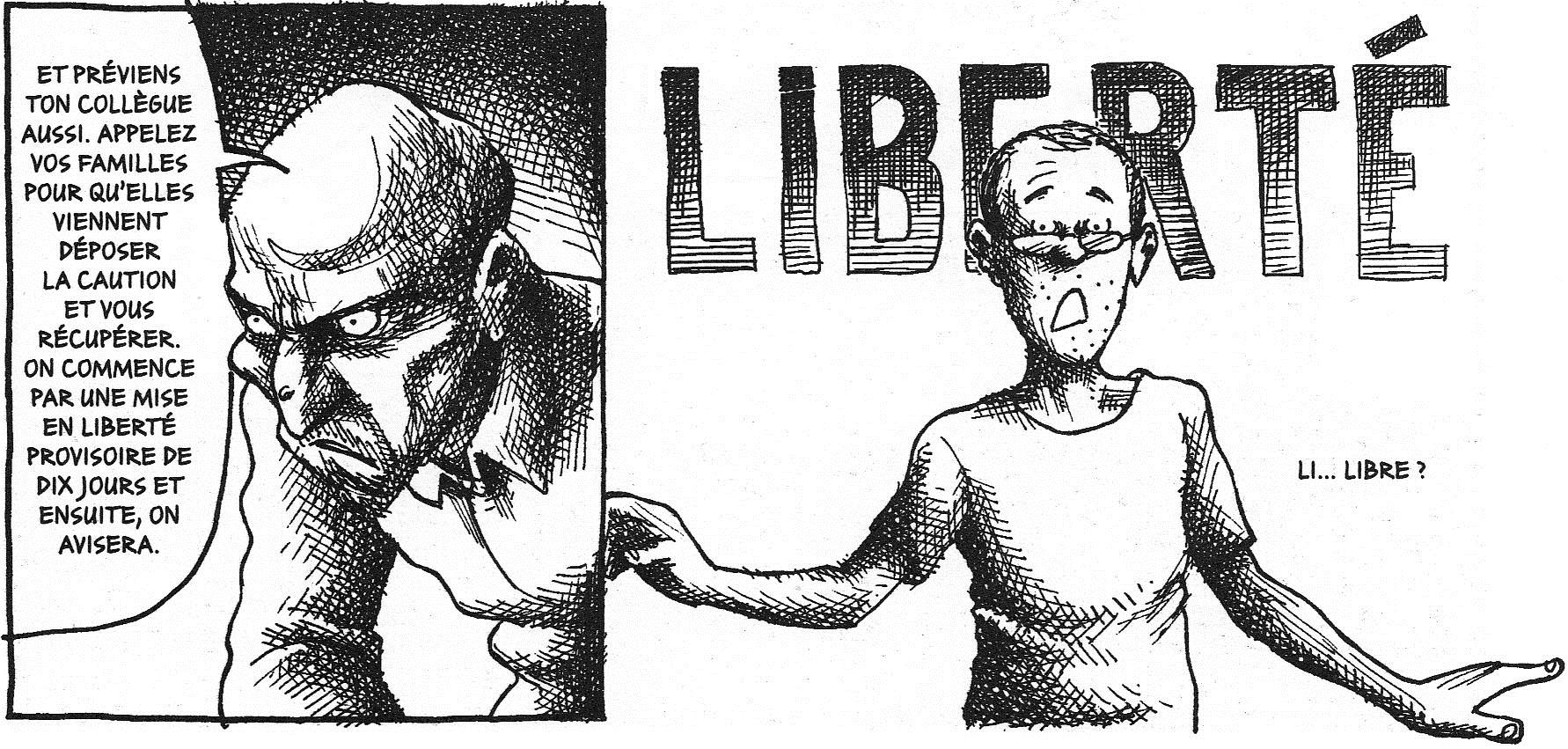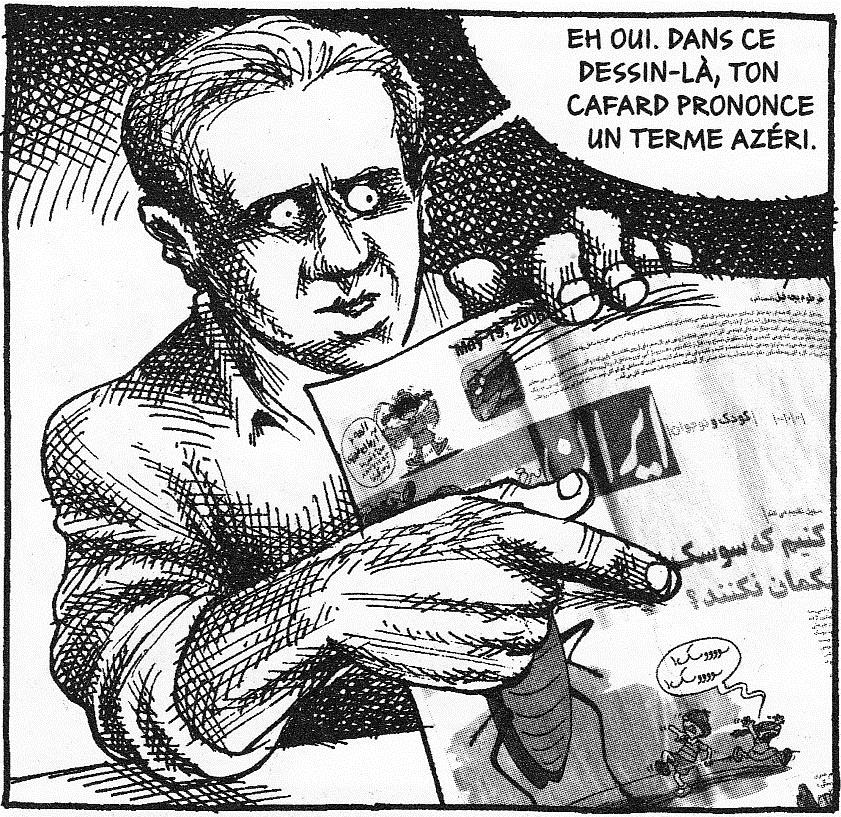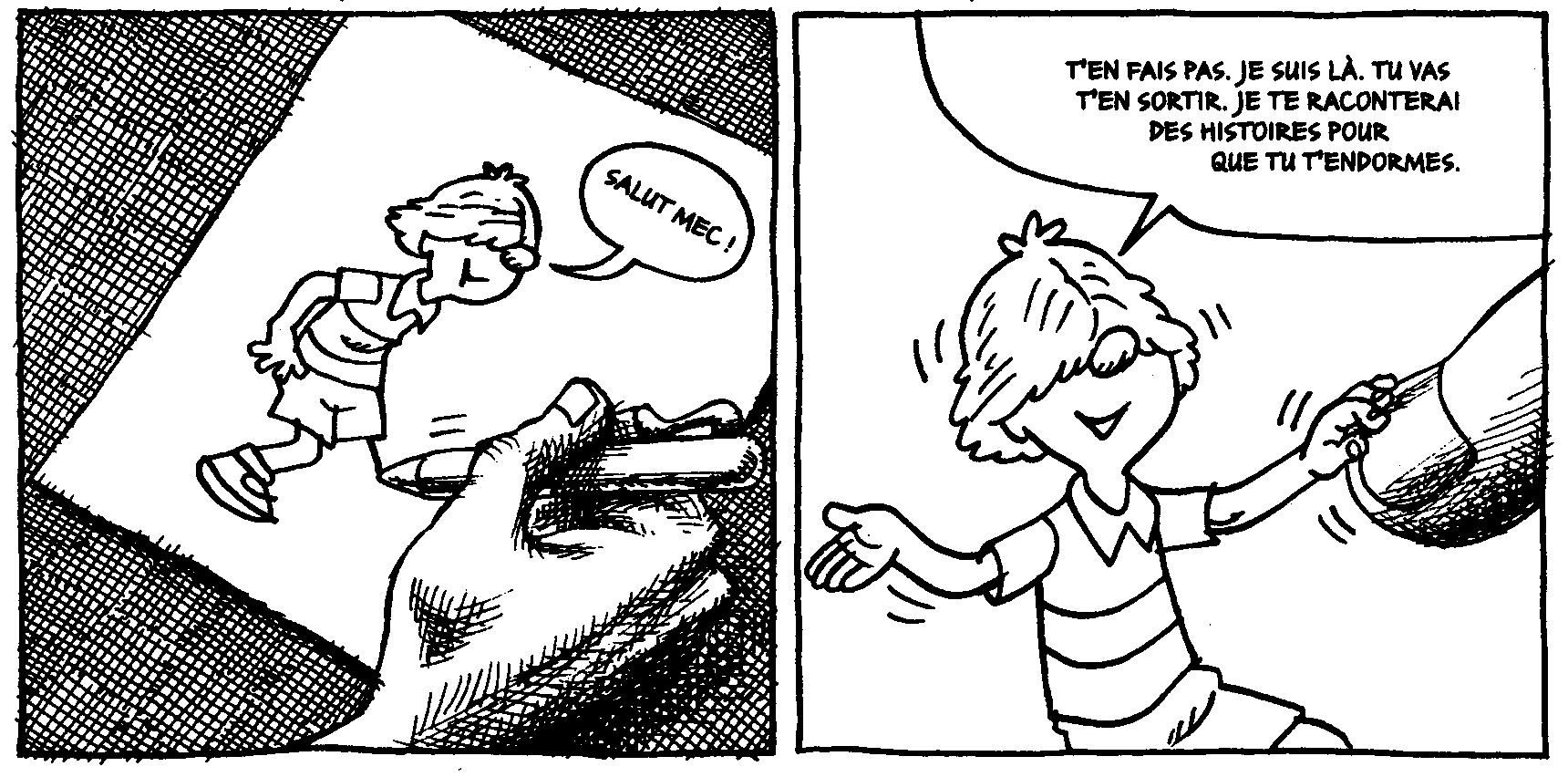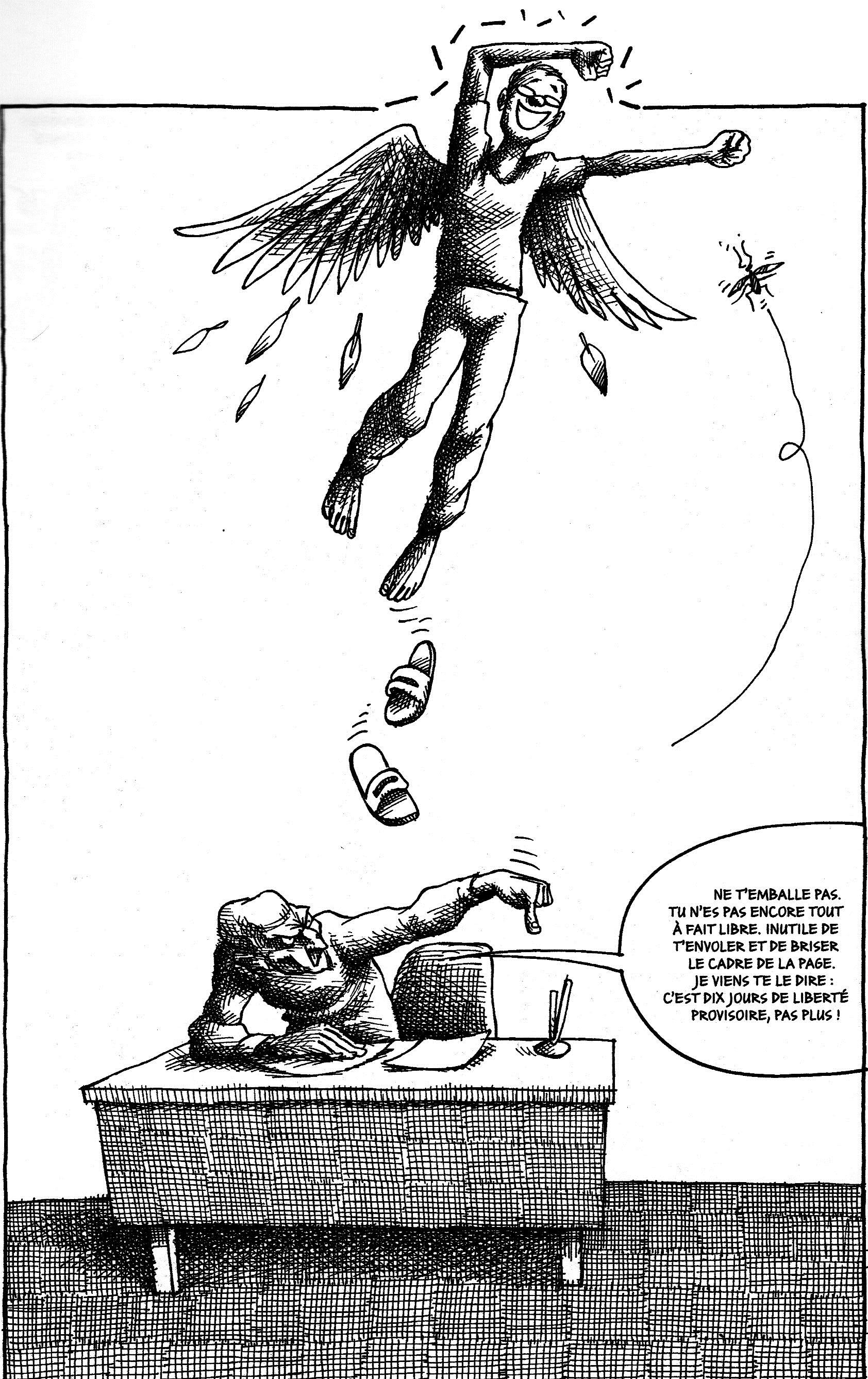|
Achim Hescher (Landau / Berlin) Transgressing Borders in and with Comics: Mana Neyestani's Graphic Novel Une métamorphose iranienne (2012)This article analyzes the motif of transgressing borders in Mana Neyestani's recent graphic memoir Une métamorphose iranienne (2012) on several planes: thematically and metaphorically, intertextually, diegetically, and genre-specifically. At first, the work is assessed historically in the contexts of bande dessinée as well as complex and experimental Francophone and Anglophone comics. A prototype approach is used to establish the graphic novel as a subgenre of graphic narratives and graphic memoirs or reportage comics as subgenres of the graphic novel. Finally, it is shown to what extent Une métamorphose iranienne fits into a prototypical category schema and how it unfolds its motif of transgression. Mana Neyestani's playfully postmodern graphic novel Une métamorphose iranienne (2012, henceforth UMI) was originally published as the French translation of a (then) unpublished English translation of a (probably) Persian manuscript.1 The press immediately likened UMI to the work of a renowned compatriot, the Iranian comics artist Marjane Satrapi, who also wrote and published her four-volume bestseller Persepolis (2000–3) in French. About half a decade after its publication, Anglo-American critics ranked Persepolis among the most outstanding graphic novels together with works like Joe Sacco's Palestine (2001) and Alison Bechdel's Fun Home (2006, cf. Chute 2006: 771, Wolk 2007: 12). Both Satrapi's and Neyestani's works feature the story of an emigration or flight from intolerable living/working conditions in Iran. The fact that UMI was first published in French made it subject to a field of comics criticism that was not bound up with genre classifications to begin with, and even less with distinguishing graphic novels from bandes dessinées. While Satrapi's French publisher L'Association has been publishing alternative French comics since 1990, UMI has come out at Éditions Ça et là, a small publisher from the Paris metropolitan area, founded in 2005, having "pour vocation de publier des adaptations de bandes dessinées étrangères" and addressing "aficionados du roman graphique ou neophytes" [as a mission to publish adaptations of foreign comics and addressing aficionados of graphic novels and novices] (http://www.caetla.fr). PhiN 70/2014: 55 1. Graphic Novels and bandes dessinées In French comics criticism – or in Anglophone criticism of French comics – distinguishing the graphic novel as a genre different from the 'comic book' or bande dessinée has never really been an issue. If you browse the MLA International Bibliography, you will almost always come across references to graphic or cinematic adaptations of bandes dessinées or classic verbal fiction. Only two major publications from the first decade of this millennium bring up 'graphic novel' in their title (Baetens 2001, McKinney 2008). Thierry Groensteen (2007 / 2013), Ann Miller (2008), Benoît Peeters (1993), and Bart Beaty (2007) mention graphic novels more or less in passing or not at all. On the French (comic) book market, we find a similar picture: there is almost never a rayon roman graphique, not even in large department stores with huge bande dessinée sections such as the FNAC. Today, Persepolis, Le photographe (Emmanuel Guibert, Didier Lefèvre, and Frédéric Lemercier 2003–6), Shenzhen (Guy Delisle 2000), and L'ascension du haut mal (David B. 1996–2004) are internationally renowned works by Francophone authors or authors publishing in French. Not quite ten years ago, Anglophone comics critics started to label them graphic novels and underscored their status as 'complex' and/or 'experimental' narratives. In this context, however, we should also account for the numerous less known complex and experimental Francophone specimens from the recent and more remote past that did not bear the graphic novel label: as early as the 1970s, with the foundation of the alternative publisher Futuropolis,2 Francophone artists started to experiment with form/layout. In 1978, the Belgian publisher Casterman issued the magazine (À Suivre), in which authors were able to go beyond the Franco-Belgian standard of 48 pages, with translations of Auclair's Bran Ruz, Hugo Pratt's Corto Maltese in Siberia, and Tardi's and Forest's Ici même (Miller 2008: 27). Yet, the main boost of works similar in length and complexity to (mainly) American graphic novels from the late 1980s3 was provided by the alternative publisher L'Association, created in 1990, which served as a springboard to success for its founders Jean-Christophe Menu, David B., and Lewis Trondheim and, subsequently, for comics artists like Joann Sfar, Jean-Claude Forest, Edmond Baudoin, Guy Delisle, and, of course, Marjane Satrapi (cf. Beaty 2007: 17–43). Something similar happened on the other side of the Atlantic, if only in more diverse ways: the changing comics culture there depended at first on the small-scale or even secret distribution of the sex- and drug infused underground comics (created by Robert Crumb, Bill Griffith, Manuel Rodriguez, and others) through record or so-called head stores; in the 1980s and 90s, it depended on small alternative publishers, providing a forum for a number of auteurs, several of them women (Jessica Abel, Julie Doucet, or Mary Fleener). These alternative publications were generally satirical, political, or (auto)biographical, often serialized in magazines (such as Zap, Raw, Acme Novelty Library), and more episodic than their successors from after the turn of the millennium, which were often immediately published in book format (cf. Hatfield 2005: 26). Important American comics artists of the alternative period were Art Spiegelman, Harvey Pekar, Chris Ware, and Daniel Clowes. What Futuropolis and later L'Association was for French auteurs, Fantagraphics (1976–) was for Anglophone alternative comics; it was followed by alternative publishers like Pacific Comics, Top Shelf Productions, and Drawn & Quarterly in the 1980s and 90s. Besides, it should be added that a small but significant number of alternative comics were self-published and today are out of print. To sum up, on both sides of the Atlantic, from the 1970s on, a new type of comics began to emerge from the shadow of the big mainstream publishers. PhiN 70/2014: 56 2. Transgressing Genre Borders: Graphic (Sub)Genres in a Prototype Approach In the discussion of comics genres, much attention has been drawn to the category boundaries, which are often perceived as 'fuzzy' (Dittmar 2008: 25). This may have been the reason why many Anglo- and Francophone experts simply refrained from distinguishing graphic novels from traditional comic books or bandes dessinées in the first place. However, it is not the fuzziness that constitutes the problem but rather the too rigid category boundaries, which lead to exclusive attributions such as, 'a work belongs to category A and not B.' With this approach, it is not possible to say, for example, 'a work belongs to both categories A and B' or 'to A rather than B' (or vice versa). Such attributions are typical of classical categories, stemming from Aristotle's Metaphysics; they are based on essential features or attributes contained in or defining a category. In comics criticism, such essential features have been, for example, a certain book length (longer than the standard American 32 or Franco-Belgian 48 pages), adult-orientation, seriousness, or thematic unity. These criteria have proved to be insufficient because they lack tangibility or specification on the one hand and induce absolute category assignments on the other, despite their blurriness (cf. Hescher 2012: 337ff.). Let me here propose the following schema with prototypical categories, of which the borders overlap and which, besides the exclusive 'is/is not,' allow for 'both/and' as well as 'rather/not' attributions:4
Fig. 1: Genre hierarchy with prototypical categories, cf. Hescher 2014: 390, Click on Image for Enlargement PhiN 70/2014: 57 This prototype schema (fig. 1) works on two axes, horizontal and vertical. The vertical axis represents superordinate and subordinate categories. Here, the term graphic narrative5 is used as a superordinate category to the cartoons,6 comic strips, and books of comics in general, the latter of which being superordinate to the traditional comic book7 and the graphic novel. Since graphic narratives are a combination of the pictorial and textual medium, they are set apart from the purely verbal narratives (the frequently used category of 'comics' as a genre or text group has been deliberately abolished). Categories on the same as well as on the next lower level distinguish themselves from the neighboring and the dominating category by at least one unique or additional feature. Travelogues like Guy Delisle's Shenzhen, for example, are a member of a subcategory to graphic novels: besides the fact that they share the stylistic devices of graphic novels – which is the reason to keep the 'novel' in the term – travelogues, like reportage comics or graphic memoirs, possess the additional attribute 'factual narrative' (the concepts 'factual' or 'authentic' are, of course, controversial, but this is beyond the scope of my investigation at this point). It is important to note that in a prototype approach, not all the category members on the horizontal axis have the same status. Despite their overlap with regard to attributes, graphic novels, comic strips, and traditional comic books are not equal, as in classical categories: "some attributes might be shared by only a few members of a category; there might even be categories with no attributes shared by all their members" (Taylor 2003: 53, the latter case is, of course, extreme and rather theoretical). – Before I elaborate more specifically on the (proto)typical attributes or features, I now propose the following, and certainly incomplete, list of Francophone long-form graphic narratives from the 1990s until recently, potential candidates to be assessed as graphic novels and ordered according to subgenres:8
Fig. 2: Francophone long-form comics from 1990 until now PhiN 70/2014: 58 What is striking about this chart – if I take it to be somewhat representative – is the dominance of graphic memoirs, that is (auto)biographic narratives, especially from the late 1990s on; this seems to coincide to a certain extent with Anglophone graphic novels from the alternative comics period and, above all, with works of this genre after the year 2000. The second largest group, the historical (graphic) novel, does not seem as prominent in Anglophone graphic literature; the only works of note I would list in this context are James Vance's and Dan E. Burr's Kings in Disguise (2006) and its follow-up On the Ropes (2013), and Alan Moore’s and Eddie Campbell’s From Hell (1999). Most graphic works from the Anglophone world with a domineering historical setting and realistic characters deal with history in a rather playful postmodern way (Moore's and Gibbons' Watchmen, for example) – just like verbal postmodern novels. The fact that many of the works in the chart were serialized or came out as prequels or sequels to one another before they appeared in book form is not a problem when we consider that equally many verbal novels, especially in the 19th century, were serialized in newspapers; also, novels have been published as sequels or prequels to other novels, marketed as trilogies, tetralogies, etc. until today. That the works above often transgress genre borders seems a common feature, shared by their Anglophone counterparts. Tardi's Stalag II B, for example, may be read as a modern historical novel and a biography; Delisle's narratives and David B.'s Journal d'Italie may be read as travelogues and autobiographies; last but not least, Mana Neyestani's Une métamorphose iranienne (2012), the focal narrative of this article, may be read as autobiography, graphic journalism, and metafiction. If many subgenres of the graphic novel transgress genre borders, what then unites them in the superordinate category? To answer this question, I shall come back to the prototype approach from above since that approach sustains and encourages the transgression of its category borders. In prototypical categories, which foster 'both/and' and 'rather/than' (instead of 'is/is not') relations and whose borders are permeable, individual works may figure in more than one category. Going up one step in the category hierarchy, the question then is what distinguishes the graphic novel from other graphic narratives, for example, the traditional comic book? And more concretely: what features or attributes does the graphic novel category contain that I would probably not find in other graphic narratives? As stipulated above, works on the same hierarchical level are distinguished by at least one additional feature which, I suggest, is complexity. That graphic novels are more complex than strips or traditional comic books has often been stated; complexity, however, which is again a complex analytical concept, would have to be specified to do justice to its own semantics and lend pertinence to an argument. In addition, the single attributes specifying the complexity of graphic novels should be graded if we plan to assess a work in terms of 'more/less complex.'9 Let me here propose a category schema with seven graded attributes of complexity aiming at the (connection of the) verbal and the visual, an aspect that has often been neglected in favor of rather blurry attributes for which gradation is not really useful.10 PhiN 70/2014: 59
Fig. 3: Complexity cline, scalar and differential, Click on Image for Enlargement The gradation works on two levels: horizontally, on the level of the single typical attributes in terms of a higher (right end) or lower degree (left end) of one attribute (the score marks of the single attributes on the continuum are conceivable only in terms of range, not of an exact spot, of course); vertically, summing up all the attribute scores comes down to a differential assessment in terms of 'both/and,' 'rather/not,' or an absolute assessment – which the schema does not preclude – in terms of 'is/not a graphic novel.' Prudhomme's Rébétiko, for example, makes lavish use color, however, it is not coded and therefore not "multireferential" (see above, attribute #7). Also, on no other attribute gradient would I make any mark at the right end of the continuum. Thus, in sum, Rébétiko lacks the complexity of a graphic novel and seems to be a lengthy but traditional comic book (absolute assessment). Neyestani's UMI, in contrast, has a multilayered plot (attribute #1), riddled with metalepses: the report of his flight from Iran via Ankara, Malaysia, and China, the stories of an airport security attendant and several prison inmates as well as Mana's nightmare episodes, which are interspersed throughout the narrative. Similarly complex is the text-image relation in several instances, which I shall analyze below (fig. 8, attribute #3). As for layout (attribute #4), Neyestani principally uses a two-by-three panel grid, verticals and horizontals with varying frame size and number of panels, splash pages and double splashes (UMI 20–1), nonframes, inter-panel space to foreshadow what will happen next (UMI 17), and text, that is narrative captions, as framing devices (UMI 68). There is only one instance of a metaleptic text-image-reader appeal (attribute #5) when the author-narrator speaks to the readers by turning 'the corner of the page' (fig. 6). Then again, UMI refers to a number of texts/media, for example to Kafka's Metamorphosis, Pinocchio, or to Leonardo's Last Supper (UMI 12, 29, 45, figs. 6, 7). Last but not least, the flagrant use of autoreferentiality and metalepsis (see below) adds to the sum total of a very high degree of complexity. PhiN 70/2014: 60 3. Transgressing Borders: of Comics, Cockroaches, and Clandestine Evasions The story of UMI is set in 2006 as the Iranian cartoon artist Mana Neyestani draws a (satirical) conversation between a child character and a cockroach in a children's supplement of the government-run weekly Iran Jomeh. The problem in the cartoon is the roach using the Persian word namana, which means something like What? but which happens to have roots in Azeri (or Azerbaijani Turkish), a language spoken by a people of Turkish origin, living in the north of Iran. The Azeri have long been suppressed by the central regime and mistake Mana's children's cartoon for an offense against them, which results in riots and violent disturbances. The regime in Teheran seems to be in need of a scapegoat and thus blames everything on Mana. Together with his chief editor, he is taken to a prison of Iran's national intelligence administration, the infamous "Section 209" at Evin. After two months, Mana is temporarily released and decides with his wife to flee from Iran. After a long journey with many setbacks and ordeals through the United Arab Emirates, Turkey, and China, they end up in Malaysia.11 UMI, the novel and its characters transgress borders in more than one sense: thematical, literal and metaphorical, intertextual, as well as diegetical. The prefatory chapter is dated "Turquie, Novembre 2006" (UMI 7), and we find the sweating artist-protagonist Mana seated at a desk at the United Nations Refugee Agency Headquarters in Ankara, Turkey, forced to write down what happened to him in the past five months, since he fled from Iran, inside a narrow empty box drawn on a sheet of paper. The bystanding supervisor admonishes him to fit his whole account inside the box. The next page displays a sequence of five panels of which four represent a flashback to Mana's internment at Evin prison, indicated by the ragged panel borders and a panel that will reoccur in exactly the same way some 35 pages later (UMI 8, fig. 4, see also 43, first panel).
Fig. 4: UMI 8, Click on Image for Enlargement PhiN 70/2014: 61 Yet, at Evin, Mana was not supposed to write everything down inside a narrow box; he rather had the problem of providing enough material to fill all the empty sheets given to him. In Ankara, now, he finds that there is too much material to fit inside the box, writes outside it and consequently has the supervisor yell at him (UMI 9, panels 1–2). This is where the prefatory chapter ends. – That the narrative starts with the theme of writing down events into limited space draws reader attention to the making of the comic book itself: here, also, diegetic space is limited to boxes or panels (framed or unframed) into which everything fits, unless the artist decides to literally have panel borders broken (UMI 120, fig. 11). The theme of Mana's excess writing, which transgresses the border of the narrow box because it does not fit inside it, links up with the cockroach, the all-pervading motif of the graphic novel: while the narrator-protagonist is taking the pains of writing his account inside the box, a roach is stealthily crawling beneath his feet and in the next panel, the excess writing is produced underneath the frame (fig. 4). The roach is the metaphor of what is too much, like Mana's excess writing and the word namana in his cartoon; and 'too much' are those who oppose the regime by raising their voices or by employing their art critically, as the Iranian government (wrongly) assumes is Mana's case. – In the first chapter following the preface, we learn from a flashback to Mana's drawing the contentious cartoon for Iran Jomeh how the roach from the paper sheet came alive and escaped from his drawing desk; in a sequence of six panels, readers follow the roach underneath the door and down the stairs of Mana's house into the street, from where it crawls across a geographical map right into the Azeri provinces to stir up trouble among the radical population (UMI 15–6, fig. 5).12
Fig. 5: UMI 16, Click on Image for Enlargement PhiN 70/2014: 62 The roach here is a metaphor of the ill-fated word namana, spreading from the weekly paper across borders into Azeri territory. – In one of his numerous nightmares by the end of the book, Mana is overwhelmed by the cockroach, whose face transmutes into Mana's mirror image and tells him, "Toi et moi, nous ne faisons qu'un ! [You and I, we're but one!]" (UMI 193 [all translations from French mine, AH]). As a matter of fact, in many episodes, Mana tries to kill the cockroach, which immediately comes back to life (cf. UMI 33, 175–6, 192); and in the final chapter, Mana realizes that they are not dissimilar and feeds it bread crumbs on the plane to Kuala Lumpur (UMI 199). One in the nightmare as in the 'real' diegetic world also is a metaphor, figuring one person too many, one to whom no country wants to grant asylum although his life is in imminent danger, a social outcast and political refugee. Mana's nightmares thicken the plot throughout the narrative, and in one instance, the same panels occur twice: the first time at the beginning of chapter two, when Mana is staying at Evin prison; the second time at the end of the penultimate chapter. In both instances, Mana dreams of a gigantic cockroach overwhelming him and of a Chinese airport security guard announcing Mana's (fictitious) internment at Goan Jo airport detention center (cf. UMI 34–5, 193–4). The dreaming of the metaphorical insect is, of course, an intertextual/intermedial reference to Kafka's Metamorphosis (1915).13 The first chapter of UMI begins with a rendition in the comics mode of Kafka's novella, depicting Gregor Samsa waking up in bed and finding himself transformed into an enormous roach (UMI 12, fig. 6).14 However, at the bottom right of the page, the artist-protagonist appears, lifting up the bottom-right corner of the panel, telling the readers, "Non ! Non ! Cette métamorphose commence aussi avec un cafard. Mais mon histoire est légèrement différente. [No! No! This metamorphosis also begins with a cockroach. But my story is slightly different.]" (Ibid.). What the artist-protagonist calls a 'slight difference' is the difference between Kafka's world-famous dream narrative and the allegorical graphic narrative about the hardships of seeking political asylum. In both narratives, the protagonists are transformed into insects: 'literally' in Kafka and metaphorically in Neyestani. This intertextual transgression is part of the framing of the plot, in which Mana, lifting up the panel corner, functions as the extradiegetic narrator of the prefatory as well as the other chapters of UMI.
Fig. 6: UMI 12, Click on Image for Enlargement PhiN 70/2014: 63 Apart from Kafka's Metamorphosis, Neyestani parodically refers to another world-famous intertext: Leonardo da Vinci's mural painting The Last Supper (Milan, 1495–8): at Evin prison in Iran, Mana is urged to write down what he knows about his artist colleagues. At the end of the page, Mana depicts himself as a kind of Judas Iscariot, sitting at the table with his artist colleagues, filling sheets with more or less innocuous information (UMI 20–1, fig. 7). The caption reads: "Je n'écris rien d'important sur ces gens et, ainsi, j'ai le sentiment de ne pas les trahir. [I am writing nothing important about these people, so I feel like not betraying them.]" (UMI 45) The parodic use of masterpieces of Western European high art to criticize the inhuman practices of the totalitarian Iranian regime is a shrewd device of Neyestani's to appeal to Western readers and open their eyes to conditions which are not limited to his home country. Doing so, he takes the artist down from the pedestal of public appreciation as he lines him up in his graphic work with the normal people who share a similar fate and are considered 'too much' (like roaches).
Fig. 7: UMI 45, Click on Image for Enlargement In this context, of course, UMI thematizes artistic freedom. After two months, surprisingly, Mana is temporarily released from Evin prison. The surprise is written in his face, and behind the artist-protagonist, we find in large capitals the lettering "LIBERTÉ [FREEDOM]" and further down to the right the very small caption, "Li… Libre? [Fr... Free?]" (UMI 119, fig. 8) This text-image15 may be read as a plea for artistic freedom (the capitals) and the questioning of it (small caption). The panel is a nonframe, thus catering to the idea of freedom, yet Mana's right hand touches the frame of the panel to his left, in which we see a grim prison attendant telling him about his temporary release. Thus, freedom is graphically and verbally restricted, limited to the one side of the panel which Mana does not touch. In these two panels, the verbal and pictorial together function as a metaphor of artistic freedom under totalitarian regimes like in Iran; with freedom thus restrained, border transgressions may happen without the artist's knowing of or intending it. PhiN 70/2014: 64
Fig. 8: UMI 119, Click on Image for Enlargement As a whole, UMI is a highly metafictional graphic narrative.16 This gains in significance against the background of the publication of the Mohammed caricatures in the Danish daily Jyllands-Posten (2005), brought back to public attention in the wake of the Muslim riots on September 11, 2012, stirred in turn by the YouTube posting of the trailer to the anti-Islamic low-budget movie The Innocence of Muslims (2012), whose artistic value has been generally denied. Similarly, making and reading comics generally is not an innocent activity, at least not anymore in our times, even if authors do not have sinister intentions when they create them. Comics may contain 'explosive content' for specific readers (as in Neyestani's case) because the readers' reception of comics depends, of course, on their socio-cultural and political context. Thus, in the first chapter, Mana is called in by his editor-in-chief, Mehrdad, who has received calls from angry Azeri parents disapproving of Mana's cartoon. The page that Mehrdad shows Mana and points his finger at looks like the photograph of the authentic newspaper page that caused the trouble; by employing shades of grey as well as pixelating, it occurs as a more realistic representation than the rest of the images in the graphic novel (fig. 9), in which rough pencil strokes and cross-hatching dominate. The fact that the newspaper page is more (photo-)realistic than all the other images seems to underscore that something unreal, fictional in nature, can become something very real in what it triggers. In other words, the fictional here transgresses the border to the diegetic factuality. The Azeri readers take the cartoon as a real offense against their ethnicity although this was by no means intended by the artist. PhiN 70/2014: 65
Fig. 9: UMI 18, Click on Image for Enlargement The metafictionality is further increased by use of metalepsis, a kind of narrative "short circuit" (Genette 2004: 14), an intrusive change of the narrative level or a deliberate and illogical transgression of ontological borders (Ryan 2005: 207–9). Neyestani uses metalepsis when Mana talks to his cartoon child (UMI 14–5), which continues to haunt him when he is in prison. Sitting at his desk, he is thinking of what he could do to his cartoon character, who suddenly comes to life and provokes Mana by bluntly accusing him of running short of ideas. Mana replies, "Tu rêves ! Je vais the mettre dans le pétrin, cette fois [...] ! [Dream on, you will have hell to pay, this time (...)!]" (UMI 14) In the last panel on this page, Mana starts to draw a cockroach, which immediately comes to life and overwhelms the cartoon child, who yells at him and swears revenge (UMI 15). Once Mana is in prison, he finds the cartoon child waiting for him in his cell, or he draws it on a sheet of paper lying on the floor, after which the child immediately comes alive (UMI 75–6, fig. 10). The cartoon child is much more iconized than Mana and lacks the cross-hatching that lends depth to the other characters and the setting. Especially in the prison episode, this leads to a complication of the plot because readers can never be certain if all this is not dreamed up by Mana, considering that the narrative is often interspersed with scenes from his daydreams and nightmares. In fact, Mana's internment and escape have turned into a Kafkaesque nightmare, and readers cannot help feeling that they are witnessing a dream from which there is no waking up. This feeling is also fostered by the way the characters are stylized: Mana himself, for example, when he is drawn stuck in the sand of an hourglass, one foot already gone through the narrowing, the bottom receptacle resembling a prison cell (UMI 132); Maître Intrépide, Mana's designated lawyer, who is drawn with a key in his back as if he were an automatic puppet wound up by the regime itself (UMI 72); Mortazavi, the inexorable judge and interrogator, who is said to have killed a woman journalist during torture and who is represented as a giant crushing Mana with his foot (UMI 62), to name but a few. PhiN 70/2014: 66
Fig. 10: UMI 75, Click on Image for Enlargement Indeed, from beginning to end, and as in Kafka's Metamorphosis, the plane of the real merges with the imaginary, and neither characters nor readers have access to a haven outside the "strange loops" (McHale 1987: 119–21) of the metaleptic narrative. A good example of this is found in chapter 14, when Mana and his wife are on the plane approaching Kuala Lumpur International Airport: a thought balloon emerging from the plane contains Mana's idea of the face of the man who is supposed to meet them at the airport and give them forged passports (the face looks evil with its eye patch and thick mustache, cf. UMI 161); outside the gate area, two men are already waiting, and one of them looks exactly like the man in the thought balloon (first metalepsis). Mana starts to talk to him, yet, it turns out that their man is the one standing next to the evil-looking one – who bears a striking resemblance to Maleki, an employee of Iran's federal intelligence agency who received them at the general prosecutor's office in Iran and who served as a mediator between the agency and Mana, once he is at Evin prison (UMI 27–9, 42–5, second metalepsis). Marie-Laure Ryan describes this type of metalepsis, which she terms ontological,17 by using the image of a serpent biting its tail: [L]a métalepse ontologique […] [,] c'est un passage logiquement interdit, une transgression qui permet l'interpénétration de deux domaines censés rester distincts. Cette opération remet radicalement en question la frontière entre l'imaginaire et le réel. On pourrait comparer […] la métalepse ontologique à une excroissance envahissante qui détruit la structure de ces tissus. […] On pourrait aussi la symboliser par l'image du serpent qui se mord la queue. (Ryan 2005: 207–8)18 Ryan goes on to write that that serpent corresponds to the notion of a 'strange loop' in Hofstadter, "un parcours qui semble mener de plus en plus loin mais qui revient paradoxalement à son point de départ [a route that seems to lead somewhere but paradoxically comes round on itself]" (ibid.: 208) – and this is what happens at the end of Neyestani's narrative: Mana and his wife are flown back from China to Kuala Lumpur, from where they already once departed in the hope of going to China by the aid of forged passports (UMI, ch. 14). The graphic novel thus is ambiguous to the extent that, again, neither characters nor readers know where they will end up after Malaysia; in this sense, the narrative is, indeed, rather short-circuited than (open-)ended. PhiN 70/2014: 67 Werner Wolf remarks that "metalepsis, as a rule, is a marker of fictionality in the sense of 'invention'. This is also the reason why genuine […] metalepsis can hardly be expected in fact-oriented genres and media such as biography, historiography or documentary film" (2005: 102, italics in the original). In this sense, UMI transgresses one more border: genre. Being an overall autobiographical narrative, it employs a device which would normally underscore a work's fictionality; here, however, it is used to disappoint the readers' genre expectations and foreground the artificiality of the narrative, which comes across as a bad dream rather than an authentic account of an escape. Wolf adds other functions of metalepsis, which seem to be pertinent in Neyestani: comic valorization (comic in its original sense) of the work in which it is used and the sensational function, "which can in fact be observed in almost all the examples [outside 'highbrow' narrative fiction]. On today's competitive market, the insertion of such surprises into comics, films etc. may also have the (additional) effect of enhancing the attractiveness of the 'product'" (Wolf 2005: 102, cf. 92, italics in the original). In this respect, the cartoon child could also be seen as a ludic device, "a certain toying with the surprise element" (ibid.).19 Does this do away with the seriousness of the work's subject? Not at all, I would hold, despite Neyestani's remark in one interview that there are certain elements in his work which he has dramatized (Caron 2012) and in another, that it is a "kind of postmodernist play" and that he likes to try out the potentials and limits of the comics medium (Shringarpure 2012). Thus, metalepsis underscores that a non-negligible part of the narrated action takes place in the artist's mind – on which the actual and authentic persecution has maybe had the greatest impact. In this context, the "toying with the metaleptic surprise element" may be read as the artist's coming to terms with the authentic persecution trauma. As Anne Whitehead writes: "Novelists have frequently found that the impact of trauma can only adequately be represented by mimicking its forms and symptoms, so that temporality and chronology collapse, and narratives are characterized by repetition and indirection" (2004: 3, qtd. in Blake 2009: par. 3). "[…] there are … a number of key stylistic features which tend to recur in [trauma] narratives. These include intertextuality, repetition and a dispersed or fragmented narrative voice" (ibid.: 84, qtd. in Blake 2009: par. 3). – Above, I have elaborated on the intertextual references to Kafka and Leonardo. Repetition and a fragmented narrative voice are found, for instance, at the end of the prefatory chapter, where the artist is shown in Ankara: forced to write down his 'travel' report inside a too narrow box, he ends up writing outside it and has the supervisor yell at him (UMI 9, panels 1–2). These two panels are repeated, and episode is picked up and continued, about 140 pages later (UMI 151, panels 1–2). PhiN 70/2014: 68 In general, Mana's narrative is interspersed with nightmares and fantasies. The sequence about Tang Lu, a Chinese immigration officer, is also dispersed throughout the narrative in four sequences, and it is not clear whether this sequence is dreamed up or 'authentic.'20 Last but not least, the roach, which follows Mana everywhere, with which he fights and which he talks to, is a (metaleptic) double or alter ego, which he encounters in his nightmares (see above) and on the plane back to Malaysia, where the narrative is short-circuited one last time.21 Mana's actual crossing the Chinese border is precarious rather than final; soon after, he and his wife are rearrested before they are finally allowed – for inscrutable reasons – to fly back to Malaysia. The breaking and transgressing of borders is, at best, temporary and no guarantee to eventually wake up from the nightmare of persecution. This is what the Evin prison supervisor meant when he said, in another metalepsis: "Ne t'emballe pas. Tu n'es pas encore tout à fait libre. Inutile de t'envoler et de briser le cadre de la page. Je viens te le dire : [...] Provisoire, pas plus ! [Take it easy. You are not totally free yet. Don't bother to fly away and break the border of the page. I just said it: […] Provisional, not more!]" (UMI 120, fig. 11).
Fig. 11: UMI 120, Click on Image for Enlargement PhiN 70/2014: 69 Works cited: B., David (1996–2004): L'Ascension du haut mal. Paris: L'Association. [6 vols.] Baetens, Jan (Ed.) (2001): The Graphic Novel. Louvain: Leuven UP. Beaty, Bart (2007): Unpopular Culture: Transforming the European Comic Book in the 1990s.. Toronto: U of Toronto P. Beaty, Bart (2008): "The Concept of 'Patrimoine' in Contemporary Franco-Belgian Comics Production", in: McKinney, Mark (Ed.): History and Politics in French Language Comics and Graphic Novels. Jackson: UP of Mississippi, 69–96. Bechdel, Alison (2006): Fun Home. Boston: Houghton Mifflin. Blake, Brandy Ball (2009): "Watchmen: The Graphic Novel as Trauma Fiction", in: ImageText 5.1, 18 pars. [http://www.english.ufl.edu/imagetext/archives/v5_1/blake, 26.9.2014] Caron, Alain (2012): "Mana Neyestani" Page 189.com. Wordpress. [http://www.page189.com/?p=1821, 26.9.2014] Chute, Hillary / DeKoven, Marianne (2006): "Introduction: Graphic Narrative", in: Modern Fiction Studies [MFS] 52.4, 767–78. Chute, Hillary L. (2010): Graphic Women: Life Narrative and Contemporary Comics. New York: Columbia UP. Delisle, Guy (2000): Shenzen. Paris: L'Association. Devitt, Amy J. (2000): "Integrating Rhetorical and Literary Theories of Genre", in: College English 62.6, 696–718. Dittmar, Jakob F. (Ed.) (2008): Comic-Analyse. Konstanz: UVK-Verl.-Gesellschaft. Genette, Gérard (2004): Métalepse. Paris: Seuil. Groensteen, Thierry (2007): The System of Comics. Jackson: UP of Mississippi. Groensteen, Thierry (2013): Comics and Narration. Jackson: UP of Mississippi. Kindle file. Guibert, Emmanuel / Lefèvre, Didier / Lemercier, Frédéric (2003–6): Le photographe. Paris: Dupuis, 3 vols. Hatfield, Charles (2005): Alternative Comics: An Emerging Literature. Jackson: UP of Mississippi. PhiN 70/2014: 70 Hescher, Achim (2012): "Analyzing Graphic Novels in Terms of Complexity: a Typology", in: Zeitschrift für Anglistik und Amerikanistik [ZAA] 60.4, 335–60. Hescher, Achim (2014): "Classical Categories, Prototypes, and the Graphic Novel", in: International Journal of Comic Art 16.1, 384–402. Kafka, Franz (1989): "Die Verwandlung", in: Ibid.: Erzählungen. Frankfurt: Fischer, 57–107. [1915] Kibedi Varga, Aron (1989): Discours, récit, image. Liège: P. Mardaga. McHale, Brian (1987): Postmodernist Fiction. London: Methuen. McKinney, Mark (2008): "An Introduction", in: McKinney, Mark (Ed.): History and Politics in French Language Comics and Graphic Novels. Jackson: UP of Mississippi, 3–24. Miller, Ann (2008): Reading Bande Dessinee: Critical Approaches to French-Language Comic Strip. Chicago: Intellect Books. Kindle file. Mitchell, W.J.T. (2009): "Beyond Comparison", in: Heer, Jeet / Worcester, Kent (Ed.): A Comics Studies Reader. Jackson, MS: UP of Mississippi, 116–23. Moore, Alan / Gibbons, Dave (2008): Watchmen. New York: DC Comics. [1986–7] Morgan, Harry (2003): Principes des littératures dessinées. Paris: L'An 2. Neyestani, Mana (2012): Une métamorphose iranienne. Bussy-Saint-Georges & Issy-les-Moulineaux: Éd. Çà et là & Arte éd. [Quoted as UMI] Peeters, Benoît (1993): La bande dessinée. Paris: Flammarion. Pfister, Manfred (1993): "The Dialogue of Text and Image: Antoni Tapies and Anselm Kiefer", in: Dirscherl, Klaus (Ed.): Bild und Text im Dialog. Passau: Wissenschaftsverlag Rothe, 321–43. Rosen, Elisabeth (2009): "The Narrative Intersection of Image and Text: Teaching Panel Frames in Comics", in: Tabachnick, Stephen E. (Ed.): Teaching the Graphic Novel. New York: The Modern Language Association of America, 58–66. Rousseau, Patrice / Gravé-Rousseau, Guillaume (2009): "Le 'roman graphique' francophone", in: L'Ecole des lettres des collèges 5–6, 103–10. Ryan, Marie-Laure (2005): "Logique culturelle de la métalepse, ou la métalepse dans tous ses états", in: Pier, John / Schaeffer, Jean-Marie (Ed.): Métalepses : Entorses au pacte de la représentation. Paris: Éd. de l'École des Hautes Études en Sciences Sociales, 201–24. PhiN 70/2014: 71 Sacco, Joe (2001): Palestine. London: Jonathan Cape. [1993–2001] Satrapi, Marjane (2000–3): Persepolis. Paris: L'Association, 4 vols. Shringarpure, Bhakti (2012): "Kafka in Iran", in: Warscapes Magazine. [http://www.warscapes.com/conversations/kafka-iran, 26.9.2014] Taylor, John R. (20033): Linguistic Categorization. New York: Oxford UP. Wagner, Peter (Ed.) (1996): Icons, Texts, Iconotexts: Essays on Ekphrasis and Intermediality. Berlin: De Gruyter. Whitehead, Anne (2004): Trauma Fiction. Edinburgh: Edinburgh UP. Wolf, Werner (2005): "Metalepsis as a Transgeneric and Transmedial Phenomenon: A Case Study of the Possibilities of 'Exporting' Narratological Concepts", in: Meister, Jan Christoph (Ed.): Narratology beyond Literary Criticism: Mediality, Disciplinarity. Berlin: De Gruyter, 83–107. Wolk, Douglas (2007): Reading Comics. How Graphic Novels Work and What They Mean. New York: Da Capo Press. Notes 1 Underneath the bastard title of the French version, we read: "Traduit de l'anglais par Fanny Soubiran [Translated from English by Fanny Soubiran]." Ghazal Mosadeq did the English translation from the original manuscript (which, I assume, is written in Neyestani's first language). In the acknowledgements, I read that the English translation, in turn, was reviewed by a certain Frazer Sutherland. Uncivilized Books, a publisher from Minneapolis, has announced its publication in English for spring 2014. There is no mention of the original language of the manuscript. 2 Futuropolis was founded in 1974, sold to Gallimard in the late 1980s, and shut down in 1994; since 2004, and with a new marketing set-up, they have been publishing comics artists like Blutch, David B., or Étienne Davodeau. For a more thorough account, cf. Beaty 2008: 69ff. and Miller 2008: 51ff. 3 The first wave of graphic novels set in with Alan Moore's and David Gibbon's dystopic superhero pastiche Watchmen (12 vols., 1986–7), Frank Miller's The Dark Knight Returns (1986), Art Spiegelman's Maus I+II (1986/92), and Neil Gaiman's Sandman series (1989–96, in collaboration with the artist Dave McKean et al.). "[J]ust about every new comics series was commissioned on the basis that it would eventually be collected into a graphic novel, while at the same time there was a rush to repackage runs of four, six or eight comics into album form even if they had no thematic unity (thus perverting the meaning of 'graphic novel' into a marketing tool). […] Moreover, the emphasis was now on adult material: it was believed that this was where the sales would be in the future." (Sabin 1996: 167, cf. Hescher 2012 : 336)4 I developed these issues systematically in Hescher 2014 . Devitt writes: "Genre theorists need to see genre as both/and rather than either/or." (2000: 705) PhiN 70/2014: 72 5 Chute's "graphic narrative" is a rather offhand definition, which she uses instead of graphic novels (Chute 2010: 3). 6 Even a one-panel cartoon implies a narrative backdrop or substratum, cf. Morgan 2003 and Kibedi Varga 1989: 98, qtd. in Groensteen 2013: ch. 2, np. From a semiotic point of view, I would argue that the single image may contain indexes of what happened before the action displayed. 7 American or Franco-Belgian format (bande dessinée) or longer, yet without the rhetorical/stylistic complexity. 8 Most works in this chart are referenced and elaborated on, more or less extensively, in Miller 2008: 57–65, McKinney 2008, chs. 5–7, 10, and Rousseau 2009: 103–10. 9 According to John Taylor, membership in a prototypical category is "a matter of gradience" (Taylor 1989: 54). 10 "There is a tendency for readers who come from literary backgrounds to read over design, as though the artwork existed only to render the plot visible and move protagonists from place to place" (Rosen 2009: 58). Generally, lengthiness (that is, distinctly exceeding the Franco-Belgian 48 or the Anglo-American 32 pages), thematic unity, and adult orientation have been brought up to distinguish graphic novels from traditional comics or bandes dessinées. However, as attributes in classical categories, they have proved to be insufficient (cf. Hescher 2012: 342). 11 Mana Neyestani and his wife will stay in Malaysia for four years. After several unsuccessful attempts to obtain a visa from several European countries as well as the U.S.A. and Canada, they are finally invited to stay in Paris. This, however, is not any longer part of the story of the narrative. 12 The narrative caption reads: "Mais sans que je m'en aperçoive, un cafard s'échappe de ma feuille / se faufile sous la porte de l'appartement / dévale les escaliers / atterrit dans la rue / et se rend jusqu'en provinces azéries, dans les villes de Tabriz et Ardebil, pour y sceller mon destin sans que je n'en sache rien. [Without me noticing it, a roach escapes from my sheet / slips out underneath the apartment door / goes down the stairs, ends up in the street / and travels into the Azeri provinces, to the towns of Tabriz and Ardebil, to seal my destiny without me knowing about it]" (UMI 15–6, slashes represent panel change) 13 As for multi-medial texts in general, the differentiation between intra- and intermedial references in such works basically collapses. Also, it depends, first and foremost, on the status we assign them: graphic novels, as in this case, can be looked at as 'texts' (in a conventional, restricted sense) as media, or as iconotexts (cf. Wagner 1996: 16). 14 The German original speaks of an "enormous bug" (ungeheures Ungeziefer) and does not further specify the bug except for its "carapace-like, hard back" – which could, in fact, belong to both a bug or a cockroach (cf. Kafka 1989: 57). 15 Cf. Hescher 2012: 353ff. W.J.T. Mitchell uses the term "imagetext," based on the very general and deconstructivist premises that the textual is in the visual and vice versa (Mitchell 2009: 116–23). Manfred Pfister divides works in which text is embedded in the image into three categories: a) works in which text functions as index, like tags or captions; b) in which text is part of the pictorial fiction, e.g. still-lifes with books whose titles can be read; c) in which text is "no longer motivated in terms of a pictorial fiction – either because there is no fiction which would or could sustain them, or because they problematize or subvert the fiction. Thus unsustained by representational conventions, letters, words, texts or even books turn into elements of the pictorial medium and become one with its other elements […]." (Pfister 1993: 323) Pfister calls this third category 'word-image' (ibid.: 322). PhiN 70/2014: 73 16 The most extreme and representative artist with respect to metafictional comics certainly is Marc Antoine Mathieu, whose series Jules Corentin Acquefacques, prisonnier des rêves (6 vols., 1991–2013) spring to mind because of the similarity of the diegetic world with a kafkaesque nightmare (the protagonist's name, "Acquefacques," is, of course, an anagram of Kafka) and the excessive use of metaleptic mises en abyme. 17 Ryan distinguishes the ontological from the rhetorical metalepsis, as can be found in narratives with zero focalization and heterodiegetic voice, when the narrator directly or indirectly addresses the readers in order to introduce a flashback, for example: "[T]his operation," Ryan writes, "has nothing contaminating, for it respects the difference of the planes. It opens a little window to another world and shuts it immediately after." (Ryan 2005: 207) 18 "[O]ntological metalepsis […] is a logically forbidden passage, a transgression allowing the interpenetration of two domains supposed to remain distinct. This operation radically questions the border between the imaginary and the real. One could compare […] ontological metalepsis to a malignant ulcer destroying the structure of the tissue. […] One could also symbolize it through the image of the serpent biting its tail." (Ryan 2005: 207–8) 19 See Wolf's analysis of metalepsis in a Donald Duck comic (Wolf 2005: 95ff., see also Ryan 2005: 222). 20 Tang Lu works at passport control and is of low rank. He lets Mana and his wife pass through immigration at Goan Jo airport despite their forged passports. The night before their arrival, Lu dreams of a comics artist from the Middle East who tries to escape from imprisonment in his own country. Being still under the influence of his dead father, a poet arrested and killed during the cultural revolution in China, Lu promises to himself on the day of Mana's arrival that he will excel at his job and triumph over his colleague, who was promoted more quickly than Lu, despite his lack of job experience. When Mana and his wife go through passport control, Lu fails to recognize the false passports and lets them pass. A little later, Lu's colleague has Mana and his wife arrested; Lu has to take the blame, and his colleague gets another promotion. – The transition to the next episode (Mana and his wife in Dubai) is achieved through a graphic match: the angle of the splash image showing Mana lying on a bed is as crooked as the picture of Lu's father on the wall; Mana himself is 'framed' at the same crooked angle by the outlines of the bed and the two blades of the ceiling fan (UMI 140–1). 21 See note 11. |


